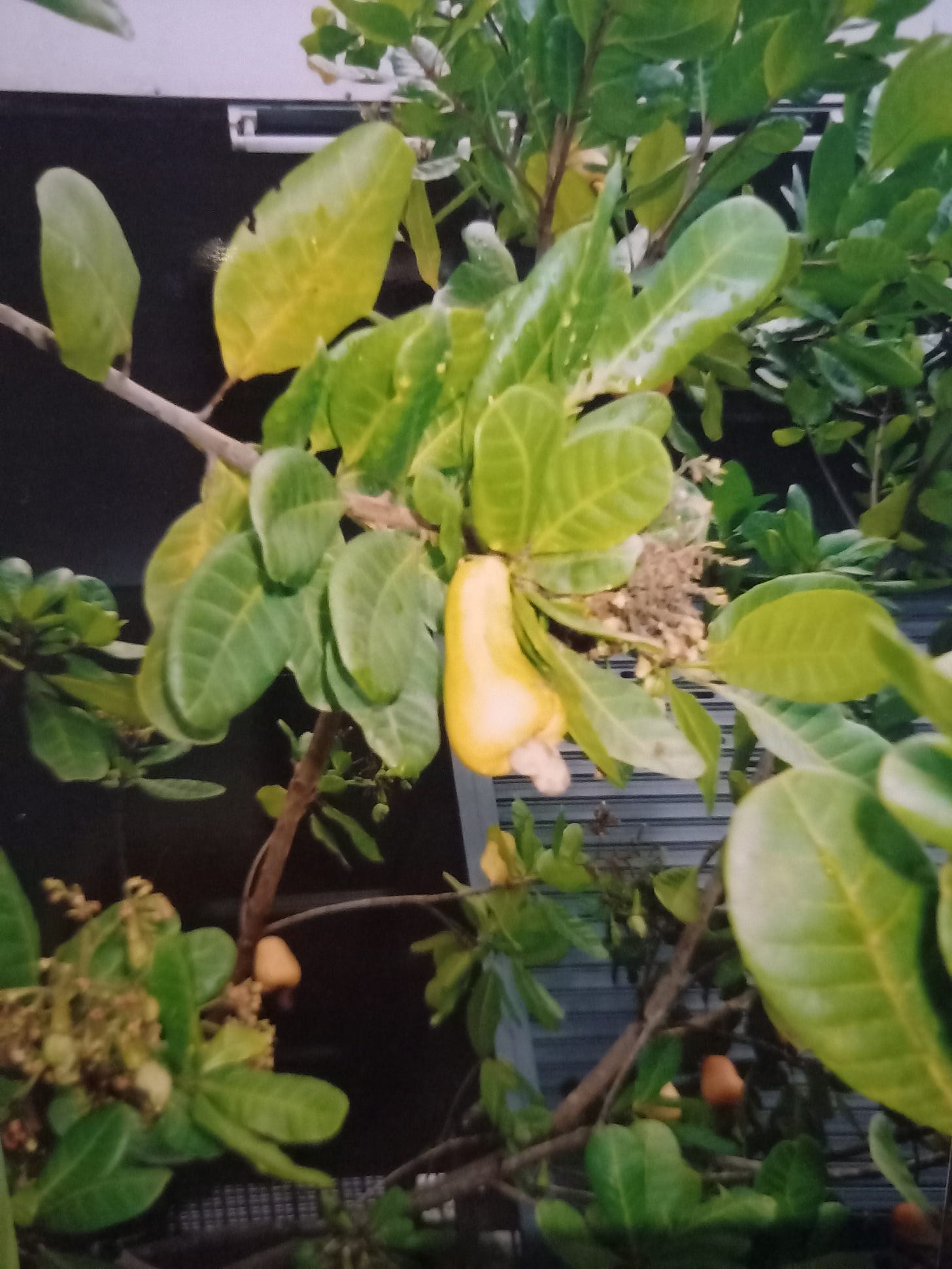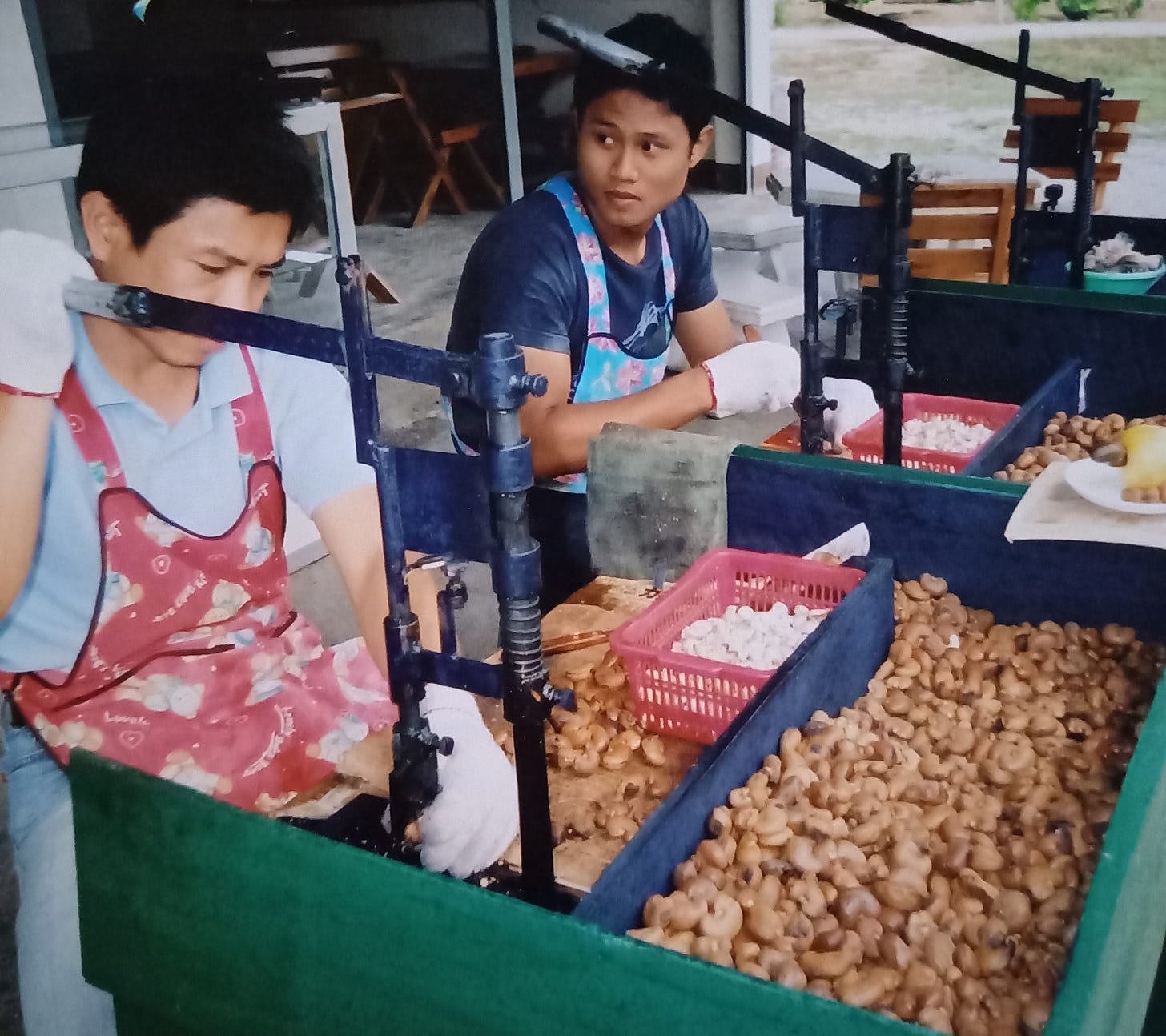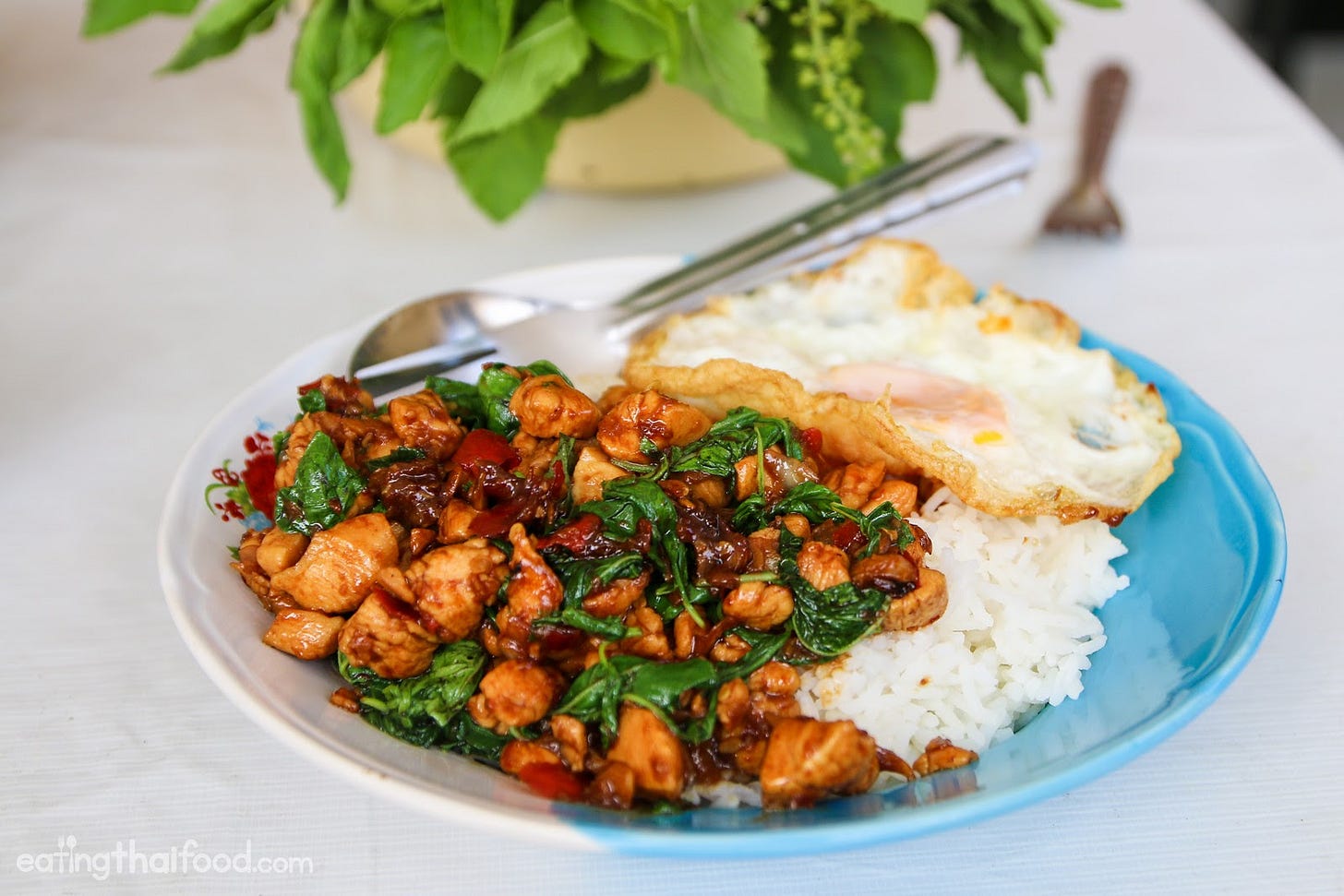If you can't travel, your tastebuds can
A recipe for Pad Kra Pao
Wahwah sashayed her way on stiletto-heeled open sandals through the market of Chang Mai, Thailand's second-largest city, in the mountainous north. She pranced lightly in a short black leather skirt, long hair flying behind her, catwalk glamorous. Weaving her way round the sellers, they waved at her cheerfully, affectionately egging on her mincing with greetings too cheeky for her to translate, she said. Some had laid fish and fruits and vegetables on plastic sheeting on the wet cement floor. Some worked at raised tables, like the stall where two men carefully crushed the rigidly resisting shells of the cashew nuts that hang singly like a comma under good-for-nothing (no, not even the juice made from them has merit) pulpy fruits.
Watching the delicacy with which they lowered the pressure of the cracking mechanism and the slowness of their pace, the reason why cashews, particularly whole ones, are so expensive became clear. Each broken nut represents a loss in profit.
Wahwah was going to teach me to cook. I rather regretted she wasn’t going to teach me how to apply make-up. She was guiding me towards the ingredients we needed to buy for our class, precise about which variety of mushrooms we needed for the six dishes she would be demonstrating.
Acquiring the right type for the different functions was imperative. You don't just buy the first mushrooms on display. Each different variety, from oyster to straw to wood ear fungus, has a specific job and cannot be substituted. Our oyster mushrooms were destined for our soup, the straw mushrooms the only ones acceptable for the curry. In its cuisine as much as in its stupahs, temples, Buddha statues, silks, floral decorations, and purported open-mindedness, Thailand historically has been a highly sophisticated society.
The market stall holders had been established with their produce in their regular spots since 5 a.m., to catch the early shoppers who arrive by 6. These customers take their ingredients home to prepare for the evening meal before heading off to work. Once everything necessary to a dish has been peeled and chopped, it can be finished in a matter of minutes when they return home.
That’s a routine we might consider emulating, to challenge the likes of HelloFresh, with its “mission to change the way people eat, forever!” and its ready-to-cook rivals who do all the prepping for us at a high cost to our wallets. What with every ingredient from single egg to teaspoon of sesame seeds being individually packaged in plastic bags or pots, it’s a high cost to the environment, too. HelloFresh has posted growth figures for 2021 of 111%, generating a turnover of €3.75 billion for the delivery worldwide of ingredients prepped and packed for more than 600 million meals. Given most of us have been confined at home for extended periods over the past 20 months, surely we might have found time for a little store cupboard organisation.
At 1 p.m. the market was almost deserted but for Wahwah and I swinging through with our baskets. Stall holders, who remain until midnight to catch the after-work customers showing up around 8, were fast asleep on deck chairs, or curled up on thick blankets on the concrete floor beneath or beside their displays.
Thais don't walk around snacking. But they do throng the streets seated on sidewalk stools at a street cook's stall from early morning on, to eat a meal they haven't the time in the rigorous working day to return home for.
Once outside Bangkok, signs of obesity are rare, though the problem is growing rapidly across Southeast Asia. "We eat three times a day," Wahwah explained. "But the most important meal is breakfast. If you don't eat a good breakfast, you lose energy in the middle of the day. Then you want to snack and eat bad foods full of salt and sugar."
Thai breakfast centres on a curry, a soup, some rice or noodles and fruit. When hunger pangs hit at lunch, a stock-based soup with noodles and vegetables keeps the worker going until the evening meal of a stir fry or a little curry over rice.
"In Thailand, we don't eat as much as you do in the West. Our bowls are small. And we don't eat as much fat as you. No butter, no cream, no cheese. When we use chicken or meat, it is mainly for flavour. But we eat a lot of vegetables that we cook very fast and eat with rice."
Although the West has generally abandoned teaching home economics and other domestic skills in schools, in Thailand it is compulsory for all high school students to take two years in some subject that will maintain traditional Thai culture. Out of dancing, sculpting, weaving and painting, Wahwah chose cookery. She is now so proficient she competes with her mother and sister in the kitchen when she goes home to visit. Her Daddy doesn’t approve. She is his favourite child, and he is only scandalised that she would want to do women’s work, she says with a cocky wink.
Deliberately or not, the Thai eating habits Wahwah is describing are of the past. With the move from an agricultural to an industrial society, traditional Thai dishes are being replaced by diets containing a higher proportion of fats and animal meat. Even in the countryside, consumption of ready-to-eat food is on the rise, with obesity and overweight among children and adolescents dramatically increased in the last 20 years, bringing with it a rise in heart disease.
In looking, in the west, for satisfactory means to combat these problems that we are responsible for introducing to the world while not depriving our taste-buds but while delivering feelings of happy satiety, increasingly we turn to the old food traditions of South East Asia and the Middle East for recipes. Pad Kra Pao, a spicy stir-fried chicken dish flavoured with licorice-y, peppery, purple-stemmed holy basil, is one out of the six that, once we had peeled and chopped all the ingredients for each of them, it took Wahwah and me a mere hour in total to cook.
Serves 2 to eat with steamed rice
100-150g/3 ½-5 ¼ oz raw rice
2 tablespoons vegetable oil
2 eggs, fried (optional)
2 cloves garlic, peeled and roughly chopped
4 small fresh chilies, roughly chopped
1 tablespoon vegetable oil
80g/3 oz chicken breast cut into bite size pieces
80g/3 ounces green beans sliced in 1/4-inch lengths
1 tablespoon each Nam Pla (fish sauce), oyster sauce, soy sauce
1 teaspoon sugar
1 good handful of holy basil leaves stripped off their stems (or regular basil but do try to get holy basil for its distinct flavour)
This is a speedy dish, so first cook the rice and set aside.
Pound the garlic and chilies together to a rough paste in a pestle or mortar or processor.
In hot oil, fry the eggs to your liking then set aside on a warm plate
Heat the oil in a wok or large saute pan over medium high heat, then add the garlic and chili paste and stir fry.
Just as the garlic softens, add the chicken and continue to stir fry till opaque, then add the beans. Stir fry, adding two or more tablespoons of water to steam-fry the beans a little.
Add the remaining ingredients except the basil leaves and toss till the liquid has been absorbed, then add the basil leaves and stir fry only till wilted, and serve with the egg over rice.




